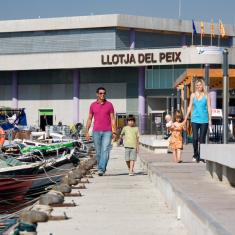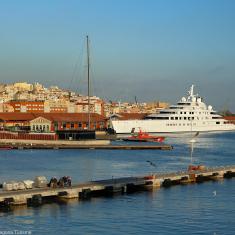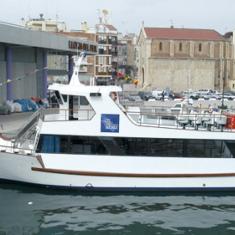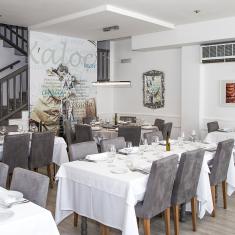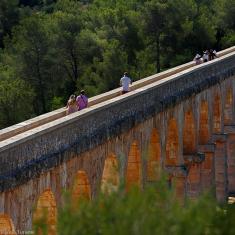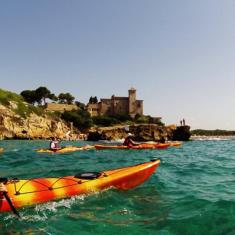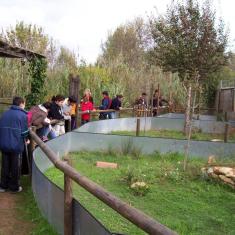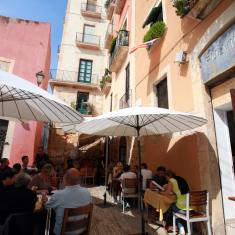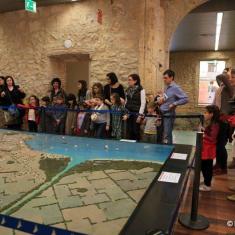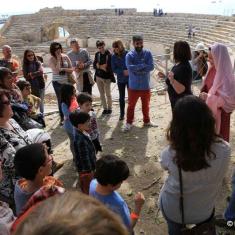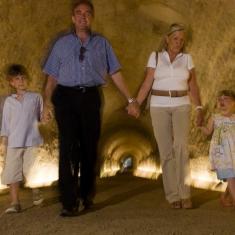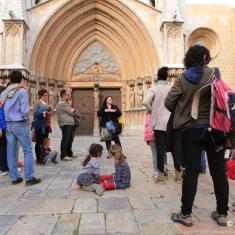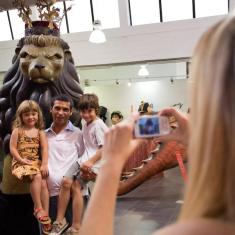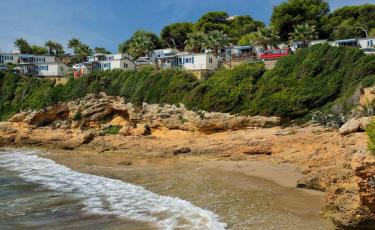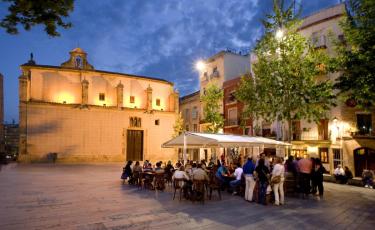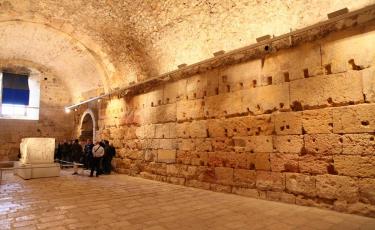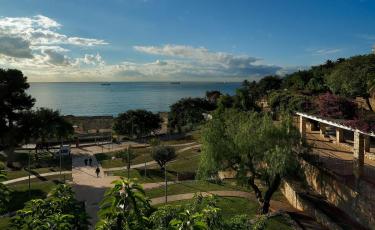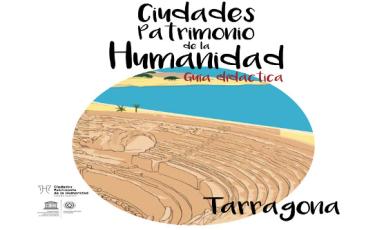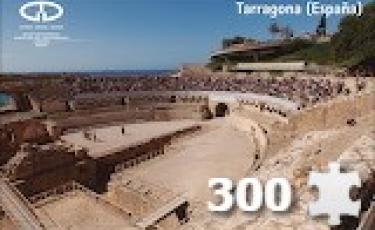Tarragona is Tarragona. El Serrallo is El Serrallo. We start off the weekend in one of the city's quarters with most character. If we arrive at around three-thirty, we will see the shown on the docks: the colourful arrival of the trawler boats, well escorted by a large group of loud seagulls. We will experience, both children and adults, the most seafaring side of Tarragona.
There is always something to do near the port area. If the afternoon is long, you may fancy a refreshment on the terraces at the Moll de Pescadors (fishermen's' dock). In the summer, there is a travelling funfair for the children to enjoy. Although, if you feel like taking a walk, the best thing is to follow the promenade of the Moll de Costa (coastal dock), of the ancient Tinglados or port storage facilities. One of these facilities holds the Port Museum, where you can learn about the fishing arts and the port's heritage, and if you book in advance, it organises interesting discovery activities for the children. Also, on summer nights, it organises guided visits through the Serrallo quarter, departing from the museum.
During the cold winter months, some of the largest yachts are moored at the piers of the Tarraco Marina. We can't go on them, but we can feel like captains onboard the Tarragona Blau, a boat that makes trips to the Cape of Salou, if we want, with lunch or dinner included. If it is late and you are still onshore, El Serrallo offers many and good options to taste the fish brought to port that afternoon. You can taste the best and greatest of the specialities of El Serrallo at the restaurant Xaloc, while, if they still have the energy, the kids can play in the park in front of the establishment.
Beyond its monuments and the busy city life, Tarragona has preserved several areas that have a high natural and heritage value, which are worth discovering with the family. The Parc ecohistòric del Pont del Diable (Devil's Bridge ecohistoric park) is a treasure full of Mediterranean diversity, lives, colours and smells that blend with the imposing aqueduct of Les Ferreres, one of the symbols of the city. The activity ' En familia' (with the family), every first Saturday of the month, invites both children and adults to discover together this Roman monument and its privileged environment.
If you prefer a beach activity, you may be interested in the Tarragona Family Kayak, a water activity especially created for family groups and available to do in the summer. Departing from the marina, after having learnt a few basic instructions on the kayak, you can then enjoy sailing along the coastline and past the beaches of El Miracle, l'Arrabassada and La Savinosa in a fun way and from a new perspective.
Another good alternative for Saturday morning is a visit to l’Hort de la Sínia, an agroecological farm next to the Natural Area of the mouth of the river Gaià and the natural beach of Tamarit. By booking in advance, families can participate in a discovery visit of the farm – feeding and collecting the eggs, if any, of hens, roosters, geese and ducks, all of which are local breeds-, get to know the land turtle (Testudo Hermani) breeding centre and the seasonal garden, as well as the sensory path, that encourages interaction with aromatic plants.
On Saturday afternoon, we will visit the historical and monumental heritage of a city tailored for kids: all, or almost all what we have to visit is at walking distance. The restaurant Pulvinar, one of Tarragona's most traditional Pizza restaurants, is located above the presidential stands of the Roman Circus, where the chariot races took place. Most of the city has actually been built over the centuries making use of the imposing structures of Tarraco, the ancient Roman capital of Hispania.
In the afternoon, the narrow streets of the Part Alta (the historic quarter) protects us from the sun and intense heat in the summer. Be sure to visit the plaça de la Font , the colourful mural at the plaça dels Sedassos, the carrer Major, and the streets Cavallers, del Comte –with the decorated blocks- and the large model of Tarraco at the plaça del Pallol, that represents the city in the 2nd Century, the period of maximum splendour. Two of the most representative monuments of the Roman set are the Amphitheatre, where the fights between gladiators took place, that is open above the Mediterranean Sea. And the Circus, only a few steps away from the Amphitheatre, entering through the Praetorium tower. Walking along the large section inside the stands of the Circus, below the current city, is a genuine experience unique to Tarragona.
Some companies offer guided visits especially designed for a family audience. Iber, for example, has organised two educational activities at the Archaeological Walk –an open area, free of cars, ideal for children to run around-, and another at the circus. With “Walking around Tarraco", Auriga offers an educational activity of approximately two hours to get to know the main elements of the Roman Tarraco. Also with Auriga you can discover the "Mysteries of the Cathedral", a temple full of stories and hidden symbols. You can also visit the Cathedral without a guide: Ask at the entrance for the educational material that makes the circuit more pleasant for children.
Next to the circus is the Casa de la Festa (The Festival House), an area where the city exhibits the traditional elements constituting the much-loved festive Retinue. Beasts, giants and dwarfs wait here the moment of taking the celebration to the streets again, a moment of joy shared by all the city of Tarragona.
There are several places recommended to have dinner with children: the Granotes Terrassa, with views to the amphitheatre and the Mediterranean Sea, in a play park away from the traffic. Yet, if we are in the Part Alta (the historic quarter) of the city, we can also have a bite in any of the many establishments between the plaça de la Font –neuralgic centre of the city in the evenings-, the plaça del Rei or the plaça del Fòrum.
Sunday is not the last day of the week, for many people it's their second day off, especially children during the school period, ready to get the most out of their time left before going back to Monday's routine. A good way to celebrate Sunday is by having breakfast in child-friendly establishments such as Cal Verdaguer, famous for their home-made pastries.
Many Sundays the National Archaeological Museum organises discovery activities suitable for families. The topics are diverse: from Roman fashion and make-up to advertising, architecture, culture or mythology. Although, if you are seeking adventure and doing some exercise, an alternative is the Jungle Trek: Zip-lines, lianas, rope swings, etc. Through different circuits, this park located in the woods offers a different way of having fun in direct contact with nature.
If we stayed in the neighbourhood of the Part Alta (the historic quarter) we would soon discover that Sundays are very lively. At around midday, the terraces of the plaça de la Font, the plaça del Fòrum and the plaça del Rei start to fill-up with local inhabitants who sit in the sun and have an aperitif, many of whom will end up staying in the area for lunch. All three urban areas- plaça de la Font, plaça del Fòrum and plaça del Rei – are safe areas and restricted to the traffic. The ideal place in the centre for the children to run around freely, play games and live a different experience in a different city.
Port Museum | Consult the schedule of activities for families and book in advance | Moll de Costa, s/n | 977 25 94 34 | ||
Tarragona Blau | Check availability | Prior booking required | Moll de Pescadors | 619 81 96 76 | ||
Restaurant Xaloc |
| Carrer Gravina, 65 | 977 24 21 95 |
| |
Tarragona – Family Kayak | TGNautica Kayak | You have to know how to swim and be older than 6 years | As from the age of 12 children can ride in individual kayaks | Activity lasts for 3 hours | Port Esportiu de Tarragona, s/n | 977 15 15 15 | ||
Hort de la Sínia | Activity lasts for 2 hours | Prior booking required | Carrer Hortes de Tamarit, s/n | 655 48 61 15 | ||
Restaurant Pizzeria Pulvinar |
| Carrer dels Ferrers, 20 | 977 23 56 31 | ||
Model of Tarraco |
| Plaça del Pallol |
| ||
Roman Praetorium and circus |
| Rambla Vella – Plaça del Rei | 977 22 17 36 / 977 23 01 71 | ||
Amphitheatre |
| Parc de l’Amfiteatre, s/n | 977 24 25 79 | ||
Archaeological Walk |
| Avinguda Catalunya, s/n | 977 24 57 96 | ||
Iber. Archaeology, Heritage and Tourism |
| Av. Països Catalans, 18 | 628 53 98 43 / 659 11 10 81 | ||
Auriga, cultural services |
| Carrer Ixart, 6 3r | 977 22 54 94 | ||
Cathedral |
| Pla de la Seu, s/n | 977 22 69 35 | ||
Casa de la Festa (The Festival House) |
| Via Augusta, 4 | 977 22 00 86 | ||
Les Granotes Terrassa |
| Parc de l’Amfiteatre s/n | 977 07 91 29 / 695 84 66 82 |
| |
Cal Verdaguer |
| Plaça d'en Jacint Verdaguer, 7 | 629 90 17 67 |
|
|
National Archaeological Museum |
| Plaça del Rei, 5 | 977 25 15 15 | ||
Jungle Trek |
| Avinguda del Blauet, 49 (Cala Tamarit) | 902 88 67 67 |
Tarraco Viva, May
The largest event of the Mediterranean intended to disseminate the Roman culture. Exhibitions, historical reconstruction, fairs, gastronomy, cinema, music and much more to discover of the Roman culture where we come from.
Sant Magí, August
The summer and water festival: A refreshing celebration for all ages. “The Entrance of the Sant Magí water” and the “Sindriada”, a music and watermelon festival, are both outstanding events.
Santa Tecla, September
The city festival in capital letters. Constantly reinventing itself, its highlight is the procession of the Arm of Santa Tecla, preceded by one of the most impressive retinues of Catalonia.




